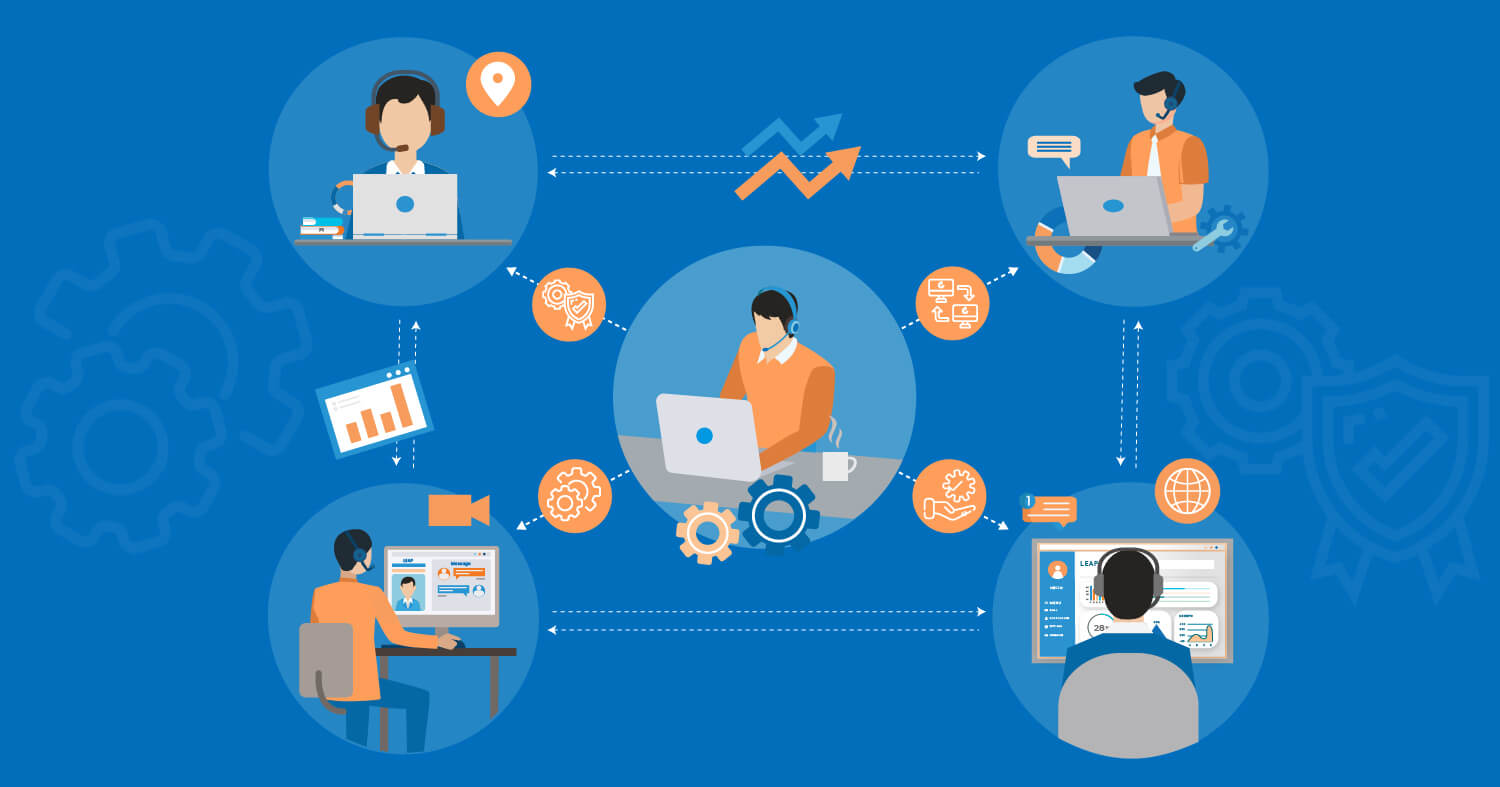
Remote network monitoring of employees involves tracking and operating remote workers’ network activity and performance to ensure productivity, safety measures, and efficient use of resources.
The current pandemic has created the need for employees to be remotely monitored. As per the research conducted by the Society for Human Resource Management, more than 70 percent of employers are finding it difficult to do so. Without tools and remote working technologies, there are solutions to monitor employees, but these are not efficient ways of conducting business.
Given that this is an unprecedented situation, managers are tasked with keeping their team members engaged and associated with using remote monitoring resources.
A paradigm shift in the working methodology of teams has created more pressure on employers to substantiate several performance benchmarks used to adjudicate resource productivity.
Although the situation differs from company to company, most organizations want to understand the productivity of their resources. They want to estimate the time and effort resources take to complete tasks. They want to check if their employees are overwhelmed with work and if it negatively affects their work-life balance.
Table of contents
Benefits of Traditional Ways to Monitor Employees
There are many traditional ways to monitor employees. Here are some of their benefits:
Sets Expectations Early
When employees are communicated about expectations very early, there is no confusion in the middle of a project. This approach is beneficial when working remotely, where there could be limited interaction between peers, colleagues, team members, or stakeholders.
If followed consistently, this type of working style helps project teams complete tasks quickly. It also allows employees to chart a course of action to complete their assignments. They can break down their task completion roadmap into regular milestones to complete their assigned responsibilities.
Promotes Dialogue
Regular dialogue or communication between an employee and their manager is important. Without regular conversations, the level of engagement an employee has with the company can be hurt. A recent report by Gartner reveals that only 13% of employees are engaged. Often, employers misinterpret employees’ engagement as being in constant touch alone.
However, the fact is that engagement transcends beyond this. It also implies subtle aspects such as building the employees’ trust in the company and keeping them motivated, interested, and performant. These are employee productivity triggers; without them, employees may not perform to their full potential.
Builds Trust
Trust goes beyond suspending micromanagement and constant follow-up. It empowers employees with the required information, support, and encouragement to feel valuable stakeholders of the larger organizational goals and success.
Employees feel trusted by making employees feel part of the system and that their contribution is benefiting the organization’s outcomes.
Once trust is invested, the employee reciprocates positively. Investing in trust is a traditional way of remote monitoring that has yielded dividends in the short and long term.
Reinforces Organizational Values
Keeping employees aware of the broader organizational objectives is critical during uncertain times. It helps employees mold themselves according to the requirements of the organization.
In behavior, conduct, performance, or working style; the employee resonates as per the organizational directives to achieve optimum performance.
The constant reinforcement of organizational values can be either periodic or cyclical, but it should never be regular, lest there is an overkill of reinforcement that could spurn everyone.
Reminding remote workers of an organization’s set of practices and philosophies helps everyone wear a common uniform of employee-ship, which helps iron out any personal differences of culture, religion, race, or background.
Focuses on Outputs
Traditional remote network monitoring allows remote working professionals a certain degree of flexibility. This is so that they can focus on outputs more than the processes.
Timeline-driven work outputs can be staggered as long as it is delivered before the cut-off time. When working from home, most people are juggling work and family responsibilities. So, enabling employees to function in new ways that are most productive for them is critical.
By reducing the emphasis on processes and focusing more on outputs, employees are encouraged to mix their schedules with personal work. This helps them get more time to reflect upon their activities and gives them creative ideas to solve work-related problems.
Improves Chances of Gaining Recognition
Working remotely is only catching up lately. There could be situations where a person might be working productively but not receiving the required level of visibility. Such a person might become disgruntled with their roles and responsibilities simply because there is a lack of a mechanism that recognizes the contributions they are making.
There are more chances of gaining visibility in a working environment where everyone is physically co-located. However, in a remote working environment, the chances of productivity visibility are lower. So, traditional remote network monitoring methods focus on increasing employee recognition by recognizing their contributions.
Encourages Innovation
Amidst uncertainty, people have come up with innovative ways to solve problems. It could be related to their daily work, families, or communities. Some people have even come up with solutions that can help organizations and national and even international governments improve the situation in their countries.
So, in a traditional remote network monitoring management style, the encouragement and support given to foster innovation are higher. Employees are asked to provide innovative ways to solve problems. Regular brainstorming sessions are conducted. Ideas are collated. The best approach to solving a problem is theorized, implemented, and evaluated.
Challenges of Traditional Remote Monitoring of Employees
The biggest challenge of traditional remote monitoring of employees is the lack of tools and technologies that can support all of these use cases.
Traditional remote network monitoring in most companies relies on outdated tools, techniques, and methodologies. Most communications happen over email and phone calls.
Most video calls are conducted to communicate between the employer and the employee, which is insufficient. Apart from that, there are several other pitfalls of the traditional monitoring of employees. Here are some:
Difficult to Track Outputs
When remotely monitoring employees, it is difficult to track their outputs. It is restricted to data entered into Excel sheets or, at the most, some web platforms or content management systems. But this does not represent the true output. There is no validation of effort or way to recognize the innovation or creativity in the production.
Often, static data is not truly representative of employee output. The need of the hour is an intelligent automated solution that is dynamically configurable as per organizational employee remote monitoring objectives.
Hard to Streamline Employee Productivity
Traditional remote network monitoring methods of email exchange, phone, or Skype calls are insufficient to streamline employee productivity.
Even a web-based portal that logs employee activity is hardly accurate. There is a chance that productivity may be incorrectly represented, as in a population of employees, many may not have the appropriate behavior. There are chances that some employees are taking advantage of the situation.
This may not be an area of concern for the organization. Still, it defeats the purpose of overall organizational productivity as an imbalance is created where certain sections of people are actively engaged in a type of activity and other sections of people are not.
Focusing on Outputs Creates Disorder and Disorganization
The best way to remotely manage employees is to balance being process-oriented and output-driven. Solely relying on outputs could foster a sluggish culture where some employees are unaware that they should utilize their freedom to empower themselves.
Rather than slowing down their performance levels and becoming disoriented and disorganized, they should raise their bar for excellence and make the best use of time. However, traditional remote management of employees does not have tools or techniques to track this aspect of organizational culture.
Setting Expectations Early Reduces Flexibility
Current remote monitoring methodologies do not have solutions that can help make project management flexible, reactive, and proactive. Although setting early expectations may be ideal, most projects have many externalities, unforeseen variables, or influences that cannot be predicted.
It could create a shift of focus or direction in the project. When such a situation happens, there should be a mechanism to communicate this change to all stakeholders.
This mechanism should also equip the stakeholders to be ready to start taking action. Unfortunately, most managers are not aware of any solution in this regard. This has resulted in haphazard management of projects, creating confusion and reducing the overall benefits of remote working.
Solutions for Effectively Managing Remote Workers
Remote monitoring of employees can be effectively conducted by applying technological solutions. Analogically, this is akin to laying down the tracks on which trains can ply.
Similarly, such technologies lay down the tracks for employees to effectively and quickly reach their objectives without wasting time, effort, and money. Here are some characteristics of a software solution that can effectively achieve remote network monitoring.
Break Management
A solution for employees to manage their break times from work.
Video Conferencing
Encrypted video conferencing with high fidelity to effectively communicate with one another.
Network Health
Checking connectivity to ensure that the Internet connection meets the minimum requirements for conducting meetings.
Seeking Help
A system to help project stakeholders seek help when in doubt and remotely troubleshoot any computer software/hardware issues.
Login Tracking
A system that is beneficial not only for employers but also for employees. It tracks the time spent logged in, improves focus towards becoming productive, and effectively manages one’s time.
Instant messaging
A solution that enables employees of an organization to collaborate over an encrypted instant messaging platform. It is ideal for informal, personal, or official communication.
Learning Tools
Classroom or web-based training can be given so that before a project starts, the required personnel is equipped with the knowledge and sufficient training.
Pre-recorded training helps people access the training anytime and reduces the cost of re-training and any time-consuming interactions.
Automated Timesheets
Time-tracking systems that are not only automated but configurable provide a way to track employee productivity effectively. They can be personalized or generalized depending on the dynamics of a project.
It is up to the discretion of the supervisor how to configure a timesheet so that it can capture important aspects of the effort and time consumed to finish a project.
Analytics
Deriving intelligence in dashboards, reports, charts, and other visualizations helps interpret data about all aspects of the business.
It can also be used to understand various data points of remote monitoring of employees, not restricted to time management, and measure engagement, trust, happiness index, morale, satisfaction, and work-life balance.
Knowledge Management Tools
In organizations, knowledge can be explicit, implicit, or tacit. Some projects may not have access to expertise that other projects have. So, by creating a knowledge management system, knowledge can be made common across all verticals or product lines of an organization.
It helps build organizational knowledge and brings all stakeholders on the same page. Without knowledge management, it is difficult to cultivate communities of practice and knowledge groups. Organizational knowledge may be lost when employees leave the company, which increases training and knowledge generation costs.
Conclusion
Leapmax is a holistic software solution that provides new-gen tools and technologies to manage remote workers effectively.
It includes an entire gamut of solutions that can be utilized to implement a robust, secure, and scalable employee tracking solution. This is not only beneficial for the employer but also benefits the employees, as it helps them retain their focus, direction, motivation, engagement levels, and productivity.







